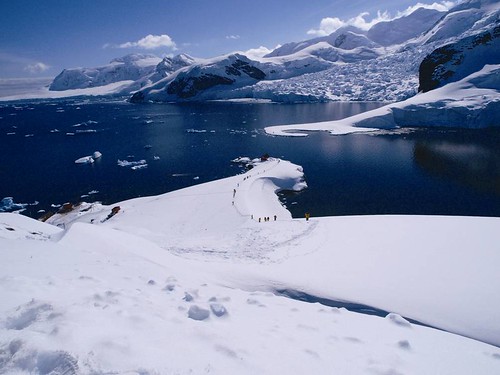結合所有海平面上升的主因,最新的研究發現,接下來數千年,地球每上升攝氏1度,海平面將升高2.3公尺。
這份跨國研究首次結合海平面上升的四個主因進行綜合分析,並與過去全球溫度變遷導致海平面上升的證據做比較。
科學家表示,影響全球海平面上升的四個主要因素是:冰河融化、格陵蘭冰蓋融化、南極冰蓋融化以及增溫造成的海水擴張。過去許多研究已各自闡述這四項成因,而這次研究是首次於單一計畫中合併此四項不同因素的嘗試。
此研究由美國國家科學基金會及德國聯邦教育及研究部贊助,成果發表在最新一期美國《國家科學院學報》(Proceedings of the National Academy of Sciences)上。
奧勒岡州立大學古氣候學者Peter Clark教授表示,「這項研究不在於估計地球將會增溫多少,或是海平面將上升多快。」
「事實上,我們試著確認的是數千年時間尺度下的海平面上升幅度;也就是說,在長時間尺度下,地球每上升1度,海平面會上升多少?」Clark解釋,「12萬年前,氣溫比現在高1-2度,當時的海平面大概比現在高5-9公尺。這和我們推算的結果一致。」
研究者透過電腦模式產生數百個模擬結果,計算四項成因對暖化的影響,發現融化的量和海平面上升的高度兩者與暖化的程度相當。
唯一的例外是格陵蘭,它似乎存在一個使反應結果明顯化的門檻。
Clark指出,「格陵蘭冰帽歷時數千年的融化和變薄後,該區溫度將會因海拔高度變低而增加。海拔高度每降低1000公尺,溫度就會上升攝氏6度。而損失的高度將加速格陵蘭冰帽的融化。」相較之下,由於南極的酷寒,所以南極海冰的融化並不會對南極冰帽帶來相同的效應。冰帽融化將造成冰山崩落,冰山飄離大陸後,將在較溫暖的海水域或是冰帽與海水間融化。
研究者注意到,上個世紀海平面上升的主因是海洋擴張與冰河融化。未來,研究者們預測,海平面上升應主要肇因於格陵蘭冰帽與南極冰帽的消融;格陵蘭冰帽會完全融化,而南極冰帽將會顯著縮小,但不會完全消失。
Clark提醒,「我們必須記得,這些模式是在數千年的尺度下,預測出溫度每上升1度海平面將上升2.3公尺。」他任教於奧勒岡州立大學地球、海洋和大氣科學學院,開授冰河與冰帽的歷史與動態、古海平面、古氣候及氣候突變。
「如果接下來兩年溫度上升了1度,海平面不會立即上升;地球必須變暖且隨著時間增加持續暖化(海平面才會上升那麼多)。」
「但我們排放到大氣的二氧化碳會留在大氣中數千年,所以即便我們降低排放,全球暖化導致海平面上升仍會是非常顯著的。」
Global sea levels will rise about 2.3 meters, or 7.5 feet, for every degree Celsius (1.8 degrees Fahrenheit) that the planet warms over the next several thousand years, finds new research that combines all the major causes of sea level rise.
This international study is one of the first to combine analyses of the four major contributors to potential sea level rise into a collective estimate, and compare it with evidence of past sea-level responses to global temperature changes.
Scientists say the four major contributors to sea-level rise on a global scale are: melting of glaciers, melting of the Greenland ice sheet, melting of the Antarctic ice sheet, and expansion of the ocean itself as it warms.
Several past studies have examined each of these components, the authors of this study say, but this is an early attempt to merge the four different analyses into a single projection.
The study, funded by the U.S. National Science Foundation and the German Federal Ministry of Education and Research, is published in the current issue of the journal "Proceedings of the National Academy of Sciences."
"The study did not seek to estimate how much the planet will warm, or how rapidly sea levels will rise," said author Peter Clark, an Oregon State University paleoclimatologist.
"Instead, we were trying to pin down the sea-level commitment of global warming on a multi-millennial time scale. In other words, how much would sea levels rise over long periods of time for each degree the planet warms and holds that warmth?"
"The simulations of future scenarios we ran from physical models were fairly consistent with evidence of sea-level rise from the past," Clark explained.
"Some 120,000 years ago," he said, "it was one to two degrees warmer than it is now and sea levels were about five to nine meters higher. This is consistent with what our models say may happen in the future."
The researchers ran hundreds of simulations through their computer models to calculate how the four components would respond to warming, Clark said, finding that the amount of melting and subsequent sea-level response was commensurate with the amount of warming.
The exception, Clark said, is Greenland, which seems to have a threshold at which the response can be amplified.
"As the ice sheet in Greenland melts over thousands of years and becomes lower, the temperature will increase because of the elevation loss," Clark said. "For every 1,000 meters of elevation loss, it warms about six degrees Celsius. That elevation loss would accelerate the melting of the Greenland ice sheet."
By contrast, the Antarctic ice sheet is so cold that elevation loss will not affect it the same way.
The melting of the ice sheet there comes primarily from the calving of icebergs, which float away and melt in warmer ocean waters, or the contact between the edges of the ice sheet and seawater.
The authors note that sea-level rise in the past century has been dominated by the expansion of the ocean and melting of glaciers.
In the future, the biggest contributions may come from melting of the Greenland ice sheet, which could disappear entirely, and the Antarctic ice sheet, which will likely reach some kind of equilibrium with atmospheric temperatures and shrink significantly, but not disappear, the authors predict.
"Keep in mind that the sea level rise projected by these models of 2.3 meters per degree of warming is over thousands of years," said Clark, who is a professor in Oregon State University's College of Earth, Ocean, and Atmospheric Sciences, where he teaches history and dynamics of former glaciers and ice sheets, paleo-sea level, paleoclimatology and abrupt climate change.
"If it warms a degree in the next two years, sea levels won't necessarily rise immediately," said Clark. "The Earth has to warm and hold that increased temperature over time."
"However, carbon dioxide has a very long time scale and the amounts we've emitted into the atmosphere will stay up there for thousands of years," he warned. "Even if we were to reduce emissions, the sea-level commitment of global warming will be significant."
※ 全文及圖片詳見:ENS








